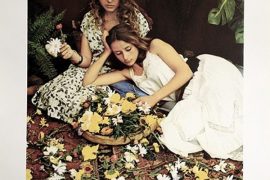[dropcap letter=”T”]
he years of the revolution were a good time to be a woman in France. Everything changed at great speed and in a favourable way for them since the capture of the Bastille on July 14th, 1789, where the scenario of the revolutionary process was conceived. Seen from the perspective of the artistic effect of this key event in history, what was done then was as it should be: an abandonment of the pose, gestures and clothing of the Rococo that was soon identified, with many reasons, such as Versailles’ style, the style identified with the hated Queen Marie Antoinette. An abandonment that was accompanied by a distance from the falseness of court rituals and attracted by a halo of authenticity, that’s why Shakespeare was liked, and not Racine: real problems -unemployment, hunger, misery- authentic violence that had to lead to the guillotine to those responsible for the calamities and, from time to time, authentic victims, of the repression of the Swiss Guard.
 But, on the other hand, everything had to be spectacle, something that did not seem serious at times, with masses blatantly obsessed with the execution of the aristocrats in the midst of great demonstrations. There was great nervousness. Also, a lot of anger. That anger that is the nourishment of the complaint. On October 5th, the people went to Versailles to shout at the king’s face the hard times they were was going through and demand reparation. The novelty of the day, which distinguishes it from July 14th, is that the leadership is then carried by women.
But, on the other hand, everything had to be spectacle, something that did not seem serious at times, with masses blatantly obsessed with the execution of the aristocrats in the midst of great demonstrations. There was great nervousness. Also, a lot of anger. That anger that is the nourishment of the complaint. On October 5th, the people went to Versailles to shout at the king’s face the hard times they were was going through and demand reparation. The novelty of the day, which distinguishes it from July 14th, is that the leadership is then carried by women.
THE NEW HELOISES
There were about six thousand, maybe more, who had the support of two of the heroes of the Bastille, Hulin and Maillard, men who did not show their alpha spirit, rather close to the female sensibility that since Rousseau had been linked to The New Heloises. Two engravings by Janinet reflect the fact; they are part of the series of 54 engravings on the revolution.
The idea that women could in the late eighteenth century exorcise the evils of a manmade society by taking decisions, saving inhibitions, is a fact that gave rise to a true mystification of the revolutionary behaviour of women, as Elisabeth Liris says. An example determines it. On September 7th, 1789, a group of eleven women appeared before members of the National Assembly to donate a chest with jewels in favour of the Nation. All are artists or relatives of artists. A spontaneous gesture that led, however, to the opening of two offices for this purpose: one directed by Madame Pajou, another by Madame Rigal; a gesture that shows how they are detached metaphorically from the symbols of the previous era. Thinking of that gesture of some Parisians, it is easy to see how women, whose political universe was defined by opinion leaders such as Marat, Danton or Robespierre, had convinced themselves of the need to carry out purgative strategies of the objects that linked them with the past.
Looking to the art that reflected the world of women in the years of the revolution, one cannot help thinking that it is an effort to situate the iconography of a certain way of being and acting, including painters of Elisabeth’s talent Vigée Le Brun were forced to change their style to adapt to the era. Revolutionary women? So, what distinguished them with regard to the shouters on the streets -those who were represented as seamstresses- who shrieked every time a cart full of women left for La Conergerie and headed for the Plaza de la Concorde where it was installed the guillotine? Were they rebels? What was their cause? At what price? Did they know the courage it took to endure weeks of police interrogation, followed by death sentences in the guillotine or several years of imprisonment? And that feeling was not only the women of the aristocracy, but also those who refused to participate in the Jacobin game of purification.
TENSIONS OF THE REVOLUTION
In spite of the great debates about the meaning of the revolution, women were involved in the entanglement of party politics. Girondins against the Mountain: diverse sensibilities, and confronted, in the conception of the revolutionary fact. Do not some of the most recognized women of these years emerge from this small world of ideological conflicts? Think of four of them, Théroigne de Méricourt, Charlotte Goday, Olympe de Gouges, Madame Tallien: four revolutionaries who were able to realize that they were in one of the crucial moments of humanity, and acted, wrote and positioned themselves with the same intensity and social effect than men. It was in Paris, in the months that followed July 1789, when the sense of revolution nested in the soul of all of them.

I do not think Théroigne de Méricourt should feel guilty for being born in the right place at the right time. Let’s look at a small-format ivory medallion by the miniaturist François Hippolyte Desbuissons, where she appears with a Girondin cap and a low-cut dress in the fashion of the moment. At twenty-seven -she had been born near Liège in 1762 in a peasant family- she represents a fortunate generation because she grew up at the rhythm of history, which was that of the ideals of the revolution. With that determined spirit, she moved to Versailles in August 1789 to follow closely the work of the National Assembly; she does it from a literary salon of political inspiration. She likes to dress as an amazon to have a masculine appearance, and she does not care if they call her the Belle Liégeoise because that holds the popularity she needs. Since January 1790 she is seen in Paris near Gilbert Romme, where she founded the Friends of the Law Club. But fame has a price. She was taken prisoner in Belgium and taken to Austria, where she remained nine months in the gloomy prison of Kufstein Castle. After nine months, she returns to Paris, where she received a triumphant welcome. It was then when she invited the women citizens to organize themselves in an armed body through a harangue that perfectly sums up her thoughts: “We are going to break our chains, finally it is time for women to come out of their shameful nullity where ignorance, pride and the injustice of men have enslaved them for so long”. Since then, her political life intensified with the participation in the assault on the Tuileries of August 10th, 92, although little by little she is committed to the wrong side of the revolution: she became a fervent Girondine, and that led to her downfall, and in the end her detention, torture and loss of reason. She was hospitalized in 1795 and there remained alien to the world until her death.
THE MARAT BATHTUB
For Charlotte Corday, everything seemed possible: unlike other young people with a revolutionary spirit, she never thought that she was capable of carrying out the plan she set out to do.

In 1793 she appears represented by Tony Robert-Fleury, as a peaceful woman with a book in her hands in a bucolic landscape of the city of Caen; this portrait reflects better her personality as a restless woman, than Paul Badry’s, where she looks like a romantic heroine. In any case, she was always seen as a woman who never felt the need to waste her time in something degrading as routine-life guided by provincial customs. History gave her a hand so that it would not happen to her. It happened in the spring of 1793, when many Girondins took refuge in Caen, fleeing the reprisals of the Jacobins led by Jean-Paul Marat. Her revolutionary ideals against the war and a federal solution for France captivated a twenty-five-year-old Charlotte Corday: she was born in 1768 at the d’Armont family, descendants of the dramatist Pierre Corneille.
She often attended spring meetings where they talked about things that did not work in the revolution and how to change them. The proposal of a federalist insurrection activated the inner world of this woman, who in July of that year went to Paris with the intention of reaching Marat and stabbing him with a knife; she did it on July 13th when she finally found herself in front of the Jacobin leader who was working as usual in a bathtub. At least from her point of view, she took the step forward that many young people of his generation did not want, or could not take. Arrested immediately, she was judged by the Revolutionary Court and executed in the guillotine on July 17th.
THE JACOBIN SCAFFOLD
 Another renowned heroine of the revolution, Olympe de Gouges, born Maria Gouze at a bourgeois Montauban family, was fully captured by Alexander Kucharski. Due to her tenacity and intelligence, she was the heiress to the long list of women writers influenced by the Mémoire de Madame de Valmont and whose Declaration of the Rights of Women and Citizenship is a milestone in the French literature of the revolutionary period, according to Michel Faucheux. The seductive attraction of this woman’s life and work is undeniable. During the revolutionary years she sought to situate herself in the reality of her time by studying ideals in depth; as she was blunt in her statements, everything she said acquired slogan value, as the famous phrase “if the woman can climb the scaffold, you should also recognize her the right to go up to the Tribune”. Her involvement with the Girondin cause led her to the guillotine in 1793, she who had been the soul of the the revolution ended her life as it is said that the counterrevolutionaries finish theirs. There was an excess of Jacobean zeal in those years; an excess of criminal feeling.
Another renowned heroine of the revolution, Olympe de Gouges, born Maria Gouze at a bourgeois Montauban family, was fully captured by Alexander Kucharski. Due to her tenacity and intelligence, she was the heiress to the long list of women writers influenced by the Mémoire de Madame de Valmont and whose Declaration of the Rights of Women and Citizenship is a milestone in the French literature of the revolutionary period, according to Michel Faucheux. The seductive attraction of this woman’s life and work is undeniable. During the revolutionary years she sought to situate herself in the reality of her time by studying ideals in depth; as she was blunt in her statements, everything she said acquired slogan value, as the famous phrase “if the woman can climb the scaffold, you should also recognize her the right to go up to the Tribune”. Her involvement with the Girondin cause led her to the guillotine in 1793, she who had been the soul of the the revolution ended her life as it is said that the counterrevolutionaries finish theirs. There was an excess of Jacobean zeal in those years; an excess of criminal feeling.
‘NOTRE DAME THERMIDOR’
The expression that today is dedicated to Olympia of being a “feminist”, surely would have amused Madame Tallien, born Teresa Cabarrús, a Madrilenian who became by her own merits in the epitome of an illustrious Parisian. From the first moment, she became a relevant figure in the Marais neighbourhood. She created there a literary salon where the most distinguished of French liberal society came. General Lafayette or Count Mirabeau or the Lameth brothers were regulars. Invoking the special authority of her prestige, she opted for the Convention, abandoning her husband, her jewels and the gallant life. The revolutionary ideal of the Girondist style leads her to the prison where she will meet the man who must watch her, who first becomes her lover, then her husband, and from whom she will receive the name by which she went down in history: Jean-Albert Tallien.

To understand the mystery of Teresa Tallien, turned by the imaginary of the revolution in Notre Dame Thermidor, we must begin considering the portrait made by Jean-Louis Laneuville, where she appears in jail with her hair cut in her hands, showing on the wall of the cell the portrait of her lover. She was the promoter of neo-Hellenic fashion, which is how she appears in the portrait of François Gérard, to which the women who frequented her salon quickly adhere. Her rise is evident by being a witness at Napoleon’s wedding with Josefine, another female icon of the revolution. But what the group surrounding Napoleon had won in position often lacked in imagination. The rejection of Madame Tallien in Napoleon’s circle after the 18th Brumaire is quite instructive in this regard. In a note to Josefine, the very first consul writes: “I forbid you to see Madame Tallien, under any pretext. I will not admit any excuse. If you hold me in esteem, you will never transgress the present order”. After this forceful Cartesian rubric, Madame Tallien left the Bonapartist circle, that was ultimately brittle and surprisingly provincial, and learned a cardinal axiom of the social life that emerged from the revolution: friends are commitments. The luck for her is that the repudiation of Napoleon opened wide the doors of the circle of Madame Staël, daughter of Minister Necker, one of the most refined minds of the time, writer, woman of the world, who introduced her to the prince of Chimay, after all, the man of her life.
At the time of the revolution, women were placed in the intellectual centre of France. The light emitted by their testimonies and the stories they tried to explain retrospectively -based on memoirs- still reach us as the radiant sun of a full moment of humanity that had a markedly feminine tone.

















